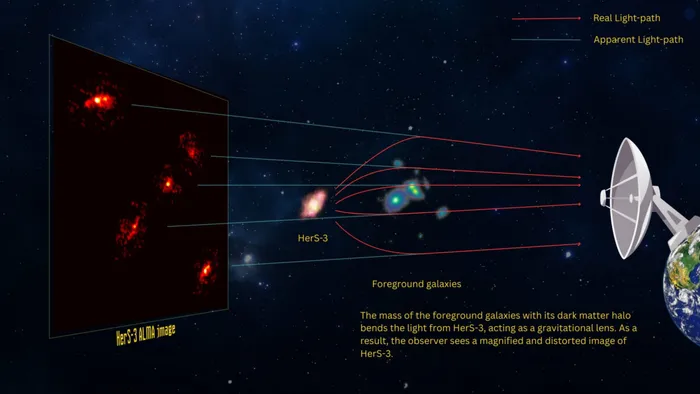Groundbreaking discovery of an Einstein Cross galaxy reveals secrets of dark matter

Einstein Cross opens a new window into studying dark matter in the distant Universe.
Image: UCT
An international team of astronomers, including one from the University of Cape Town (UCT), has made a groundbreaking discovery: a rare "Einstein Cross" galaxy in the early Universe.
This celestial phenomenon presents as four brilliant images arranged in a cross, with an additional fifth image shining at the center.
This extraordinary effect, detailed in a paper titled “HerS-3: An Exceptional Einstein Cross Reveals a Massive Dark Matter Halo” published in the Astrophysical Journal, is attributed to gravitational lensing.
This occurs when the immense gravity of massive galaxies bends light from a more distant galaxy, intensifying its brightness and causing it to appear multiple times in the sky.
The university said, what makes this particular system even more intriguing is the presence of five images, whereas an Einstein Cross typically displays four.
It explained that the galaxy, named HerS-3, is located approximately 11.6 billion light-years away. Its light is being distorted by a cluster of galaxies situated much closer to us, about 7.8 billion light-years away, collectively forming this striking cross pattern. These observations were made possible by some of the world's most powerful telescopes, including NOEMA, ALMA, the VLA, and the Hubble Space Telescope.
It added that what truly elevates this discovery is that the visible galaxies alone cannot account for the five-image arrangement.
The only plausible explanation for this pattern necessitates the presence of an enormous, invisible halo of dark matter. This mysterious substance constitutes about 80% of the Universe's matter but emits no light. In this instance, the dark matter halo is estimated to be several trillion times the mass of the Sun.
Dr. Lucia Marchetti of UCT’s Department of Astronomy, who spearheaded the Hubble observations, expressed her astonishment: "Seeing this system was a real surprise; it’s something we’ve never observed before." She added, "It opens a new window into studying dark matter in the distant Universe, at a time when galaxies were far more active than they are today."
The university added that this discovery holds significant importance as such systems function as natural cosmic laboratories. They allow scientists to scrutinize galaxies from the early Universe with unprecedented detail. Concurrently, they offer novel avenues for studying dark matter, the unseen mass that plays a pivotal role in shaping galaxies and the Universe itself.
Get your news on the go, click here to join the Cape Argus News WhatsApp channel.
Cape Argus